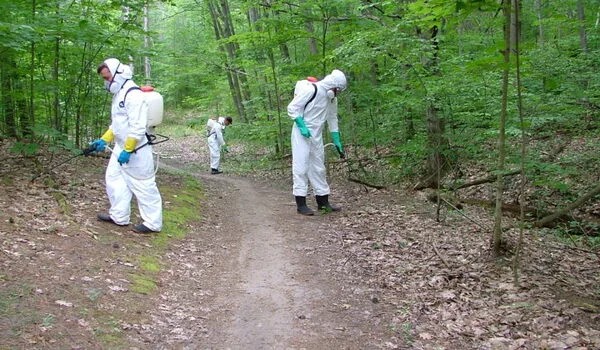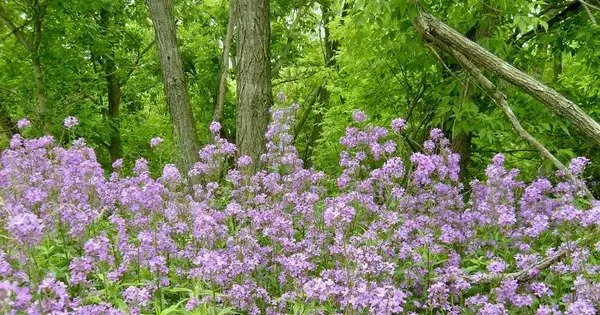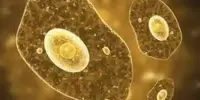Some non-native plants grown in public gardens or arboretums are escaping and becoming invasive in natural forests. Denis Conover, a botanist, does not have to travel far to investigate the growing problem of invasive plants. The biology professor pointed out numerous examples of nonnative, invasive species in campus landscaping during an autumn stroll outside his office at the University of Cincinnati.
“This is a winged euonymus, also known as a burning bush.” Here’s some Chinese silver grass. “It’s a common ornamental, but the seeds are dispersed by the wind,” he explained.
There were plenty more: English ivy, wintercreeper, and Callery pear. He and his students investigated the impact of nonnative, invasive plants on forests in their most recent study, which was published in the journal Ecological Restoration. He discovered that plants in arboretums and public gardens can accidentally seed wild areas with nonnative plants.
“The nonnative, invasive species are very detrimental to native ecosystems,” he said. “Once they get going in the natural areas, they can take over and exclude the native plants and the animals that depend on them.”
The nonnative, invasive species are very detrimental to native ecosystems. Once they get going in the natural areas, they can take over and exclude the native plants and the animals that depend on them.
Denis Conover
He used the arboretum at Cincinnati’s Spring Grove Cemetery as an example, which has recorded over 1,200 species of trees, shrubs, vines, and other plants over its 178-year history. The arboretum is home to 26 notable mature trees that have been designated as “champions” for being the largest or best representation of their species, including a national champion September elm tree and an Ohio champion American yellowwood.
According to Conover, the arboretum is home to many beautiful native plants, including a massive white oak that was a sapling when the Mayflower arrived in Plymouth Colony. However, Conover claims that some exotic plants at the arboretum are producing fruit and seeds that are being carried to neighboring woods by birds or the wind. Some exotic plants introduced to people’s yards and gardens will never pose a problem. But others can become invasive.
“You don’t know. It may take decades before they show any signs of being invasive, like the Callery pear tree,” Conover said.
UC has documented thousands of native and nonnative plant specimens at Spring Grove in surveys by people such as Kate Nordyke, the cemetery’s former herbarium specialist. Conover now serves in that role as a volunteer, documenting plants to create a record that future scientists can use to study changes in the region’s biodiversity over time.

“Despite its proximity to the city center, there is a substantial amount of intact greenspace at Spring Grove and the surrounding community,” he said. “This, in turn, supports a surprising diversity of plants and animals.”
Nordyke expressed concern about the ease with which some cultivated plants have spread to natural areas.
“Seeing this brought to light even more the importance of making informed choices about what we plant in our own yards and gardens,” she went on to say. One example, according to conservation technician Drew Goebel of Cincinnati City Parks, is the cemetery’s beautiful Amur cork tree, a state-record tree. Parker Woods Nature Preserve, a park adjacent to the cemetery, is sprouting its seeds.
“There we found a population of 25 mature Amur cork trees. We took core samples and found that the oldest of them was 60 years old. The oldest six trees are male but then a female tree sprouted there and they began to take off,” Goebel said.
And nine years ago, volunteers cleared acres of nonnative, invasive Amur honeysuckle from Cincinnati park’s Buttercup Valley Nature Preserve, creating fertile ground for another invasive species, Higan cherry, to take hold, he said. “We found a big stand of them — 50 or 60 that we pulled out all at once,” he said.
“The reason we don’t have more of these other invasives showing up is because another dominant invasive, Amur honeysuckle, was introduced in greater numbers and has already taken over that niche,” Goebel said. Conover said Spring Grove has several large Higan cherry trees native to Asia.
“The trees have attractive flowers in the spring, but the fruits are eaten by birds that disperse the seeds into the natural areas,” he went on to say. Spring Grove Cemetery’s director of horticulture, David Gressley, says the cemetery is taking important steps to combat the spread of invasive species. The cemetery began replacing English ivy and wintercreeper, two common invasive species, with native ground covers.
“This is the first full season where I had a crew dedicated to invasive plant control,” said Gressley. They were successful in removing English ivy from a champion bald cypress tree. They also started removing porcelain berry, an Asian vine known for its beautiful blue and purple berries.
“We definitely put a dent in it,” he said. “It’s a continuous battle.”
Why does it matter?
“People who are trying to protect natural areas and preserve native plants and animals are spending huge amounts of time and money to eradicate nonnative, invasive plants,” Conover said. “The overuse of herbicides and mechanical equipment results in collateral damage to native plants and animals and to people.”
Meanwhile, people continue to buy and plant invasive trees, shrubs, and flowers in their yards rather than native alternatives that benefit insects, birds, and other wildlife, according to Conover. According to Goebel, forests dominated by invasive species degrade in multiple ways over time. According to him, Amur honeysuckle shades out and kills native ground-hugging plants and vines. These forests do not retain as much water or soil as native forests and provide far less wildlife habitat than native forests with their diverse species.
“It’s not providing the same benefits to us, either, that a native forest would,” Goebel said. “It’s not going to sequester the same amount of carbon. It’s not going to mitigate stormwater runoff like it normally would. It weakens the whole system when it’s reduced to just a few species.”
But Goebel said there’s still time to do something about it.
“The good news is that we’re only at the start of the problem. “The best time to intervene is when we can persuade people to act when the problem is small,” he says. “When it gets to the stage where it’s out of control like honeysuckle, you get to a breaking point where it’s just infeasible to deal with it.”
Olivia Canterbury, a UC graduate and study coauthor, believes that more should be done to educate people about invasive species, particularly emerging ones that could pose a problem. Her father, ornithologist Ronald Canterbury, is a biology professor at UC.
“I was taken aback by the number of nonnative species I saw in Cincinnati’s wooded areas,” she said. “I think our best solution is to keep bringing awareness to the issue and encouraging planting native species.”
Samantha Al-Bayer, a UC graduate, is now working in Guam, an island with a long history of dealing with invasive species like brown tree snakes, which have wiped out native birds.
“Invasive species hit a lot harder and faster on islands,” he said. “This is due to the island’s isolation and the lack of natural predators to control foreign species.”
When the birds vanished, many plants lost their best or only means of seed dispersal. Officials on Guam are on high alert to prevent brown tree snakes from stowing away on airplanes or boats and making their way to other nearby islands, she said.
“This is especially important for cargo being shipped to any of the other Marianas islands since those islands are still free of brown tree snakes and still have beautiful endemic birds,” he said. Conover believes that homeowners can help combat invasive species by first removing any that are on their properties. He added that they can choose to replace them with native trees, shrubs, and flowers.
“A ginkgo tree supports virtually none of our native insects or birds,” he went on to say. “However, if you plant a white oak, several hundred species of insects will eat its leaves, providing food for birds in addition to its acorns. Plant an oak,” he advised.
















